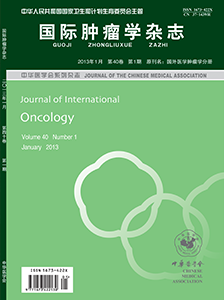LSD1、MGMT和Ki-67在高级别胶质瘤中的表达及对预后的影响
引用次数: 0
Abstract
Objective To investigate the expressions of histone lysine-specific demethylase 1 (LSD1), O6-methylguanine DNA methyltransferase (MGMT) and cell proliferation-associated antigen Ki-67 in high-grade glioma and their influences on prognosis. Methods Sixty-five cases of grade Ⅲ and Ⅳ glioma confirmed by pathology from January 2011 to June 2017 in the First Affiliated Hospital of Xinjiang Medical University were selected. Immunohistochemistry (SP method) was used to detect the expressions of LSD1, MGMT and Ki-67 in pathological specimens. The therapeutic effect was evaluated by long-term follow-up. The relationships between the three markers and pathological grade, progression-free survival (PFS) and overall survival (OS) were analyzed. Results The overall positive rates of LSD1, MGMT and Ki-67 in the 65 high-grade glioma specimens were 70.8% (46/65), 60.0% (39/65) and 100.0% (65/65), respectively. There were no significant differences in the expressions of LSD1 and MGMT in grade Ⅲ and Ⅳ glioma (χ2=1.588, P=0.208, χ2=0.013, P=0.908). Ki-67 expression (+ ), (+ + ), (+ + + ) in grade Ⅳ glioma were observed in 18, 19 and 11 cases, respectively. Ki-67 expression (+ ), (+ + ) in grade Ⅲ glioma were observed in 11, 5 cases, and 1 case was (+ + + ), and the difference in expression intensity between the two groups was statistically significant (Z=-2.083, P=0.037). Log-rank test showed that the positive expressions of LSD1, MGMT and Ki-67 were negatively correlated with the PFS of patients with high-grade glioma (χ2=12.217, P=0.007; χ2=4.446, P=0.035; χ2=12.536, P=0.002), also were negatively correlated with OS (χ2=11.708, P=0.008; χ2=6.637, P=0.010; χ2=11.807, P=0.003). Grade Ⅳ patients were more likely to have relapse progression than grade Ⅲ patients (χ2=6.573, P=0.010), and OS was shorter (χ2=3.974, P=0.046). Cox proportional hazards model analysis showed that the expressions of LSD1 (HR=1.361, 95%CI: 1.094-1.694, P=0.006; HR=1.406, 95%CI: 1.117-1.771, P=0.004) and Ki-67 (HR=1.703, 95%CI: 1.175-2.468, P=0.005; HR=1.778, 95%CI: 1.209-2.616, P=0.003) were the independent prognostic risk factors for PFS and OS of patients with high-grade glioma. Correlation analysis results showed that the expression of MGMT was positively correlated with the expression of LSD1 (r=0.406, P=0.001). Conclusion LSD1, MGMT and Ki-67 have higher positive expression rates in high-grade glioma. MGMT is a prognostic factor for high-grade glioma, and LSD1 and Ki-67 can be used as independent predictors of prognosis for high-grade gliomas. Key words: Glioma; O(6)-methylguanine-DNA methyltransferase; Ki-67 antigen; Prognosis; Lysine specific demethylase 1LSD1、MGMT和Ki-67在高级别胶质瘤中的表达及对预后的影响
目的探讨组蛋白赖氨酸特异性去甲基化酶1 (LSD1)、o6 -甲基鸟嘌呤DNA甲基转移酶(MGMT)和细胞增殖相关抗原Ki-67在高级别胶质瘤中的表达及其对预后的影响。方法选择2011年1月至2017年6月新疆医科大学第一附属医院经病理证实的Ⅲ级和Ⅳ级胶质瘤65例。采用免疫组化(SP)方法检测病理标本中LSD1、MGMT、Ki-67的表达。通过长期随访评价治疗效果。分析3种标志物与病理分级、无进展生存期(PFS)和总生存期(OS)的关系。结果65例高级别胶质瘤标本中LSD1、MGMT和Ki-67的总阳性率分别为70.8%(46/65)、60.0%(39/65)和100.0%(65/65)。LSD1、MGMT在Ⅲ、Ⅳ级胶质瘤组织中的表达差异无统计学意义(χ2=1.588, P=0.208; χ2=0.013, P=0.908)。Ki-67在Ⅳ级胶质瘤中的表达(+)、(+ +)、(+ + +)分别为18例、19例和11例。Ki-67在Ⅲ级胶质瘤中表达(+)、(+ +)分别为11例、5例,(+ + +)1例,两组间表达强度差异有统计学意义(Z=-2.083, P=0.037)。Log-rank检验显示,LSD1、MGMT、Ki-67阳性表达与高级别胶质瘤患者PFS呈负相关(χ2=12.217, P=0.007;χ2 = 4.446,P = 0.035;χ2=12.536, P=0.002),且与OS呈负相关(χ2=11.708, P=0.008;χ2 = 6.637,P = 0.010;χ2 = 11.807,P = 0.003)。Ⅳ级患者比Ⅲ级患者更容易出现复发进展(χ2=6.573, P=0.010), OS更短(χ2=3.974, P=0.046)。Cox比例风险模型分析显示,LSD1的表达量(HR=1.361, 95%CI: 1.094 ~ 1.694, P=0.006;HR=1.406, 95%CI: 1.117 ~ 1.771, P=0.004), Ki-67 (HR=1.703, 95%CI: 1.175 ~ 2.468, P=0.005;HR=1.778, 95%CI: 1.209 ~ 2.616, P=0.003)是高级别胶质瘤患者PFS和OS的独立预后危险因素。相关分析结果显示MGMT表达与LSD1表达呈正相关(r=0.406, P=0.001)。结论LSD1、MGMT、Ki-67在高级别胶质瘤中有较高的阳性表达率。MGMT是高级别胶质瘤的预后因子,LSD1和Ki-67可作为高级别胶质瘤预后的独立预测因子。关键词:胶质瘤;O (6) -methylguanine-DNA甲基转移酶;ki - 67抗原;预后;赖氨酸特异性去甲基化酶
本文章由计算机程序翻译,如有差异,请以英文原文为准。
求助全文
约1分钟内获得全文
求助全文

 求助内容:
求助内容: 应助结果提醒方式:
应助结果提醒方式:


